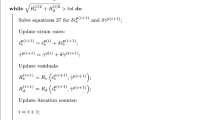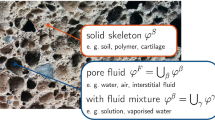Abstract
Mesoscale simulation of fluid-saturated porous materials is used to investigate unvalidated assumptions in continuum modeling of geomaterials at high rates. The importance of pressure-dependence of the matrix material on the applicability of the effective-stress approach during plastic deformation is explored. The hydrostatic load-unload response of saturated porous structures having both pressure-dependent and pressure-independent matrix materials is modeled using the material point method. Results are used to validate a semi-empirical strain-to-yield effective-stress model in which the pore pressure evolves with local material deformation, an approach that is applicable to materials with closed porosity or those loaded at sufficiently high rates that fluid transport can be neglected. Mesoscale simulations are used to estimate the strain rates beyond which fluid flow through the matrix can be neglected.




























Similar content being viewed by others
Notes
Throughout this manuscript an overbar denotes a value that is positive in compression, so \(\bar{\star }=-\star\), where \(\star\) could be \(I_1\), \(X\), \(\zeta\), etc.
References
Borja RI (2006) On the mechanical energy and effective stress in saturated and unsaturated porous continua. Int J Solids Struct 43(6):1764–1786
Gupta A, Bayraktar HH, Fox JC, Keaveny TM, Papadopoulos P (2007) Constitutive modeling and algorithmic implementation of a plasticity-like model for trabecular bone structures. Comput Mech 40(1):61–72
Karrech A, Poulet T, Regenauer-Lieb K (2012) Poromechanics of saturated media based on the logarithmic finite strain. Mech Mater 51:118–136
Lenaerts T, Adams B, Dutré P (2008) Porous flow in particle-based fluid simulations. ACM Trans Graph 27(3):49:1–49:8
Anandarajah A (2010) Computational methods in elasticity and plasticity: solids and porous media. Springer. ISBN 9781441963789
Hagelberg C, Swift R, Carney T, Greening D, Hiltl M, Nellis W (2000) Modeling shock recovery experiments of sandstone. In: AIP conference proceedings; 2. IOP INSTITUTE OF PHYSICS PUBLISHING LTD, pp 1275–1278
Homel MA, Guilkey JE, Brannon RM (2016) Continuum effective-stress approach for high-rate plastic deformation of fluid-saturated geomaterials with application to shaped-charge jet penetration. Acta Mechanica 227(2):279–310
Brannon R, Fossum A, Strack O (2009a) Kayenta: theory and user’s guide. Sandia Report
Biot MA (1941) General theory of three-dimensional consolidation. J Appl Phys 12(2):155–164
Terzaghi K (1936) The shearing resistance of saturated soils and the angle between planes of shear. First Int Conf on Soil Mech and Found Engr, Harvard University I:54–56
Nedjar B (2012) Formulation of a nonlinear porosity law for fully saturated porous media at finite strains. J Mech Phys Solids
Buhan PD, Dormieux L (1996) On the validity of the effective stress concept for assessing the strength of saturated porous materials: A homogenization approach. J Mech Phys Solids 44(10):1649–1667
Xie S, Shao J (2012) Experimental investigation and poroplastic modelling of saturated porous geomaterials. Int J Plast 39:27–45
Lomov I, Hiltl M, Vorobiev OY, Glenn L (2001) Dynamic behavior of berea sandstone for dry and water-saturated conditions. Int J Impact Eng 26(1):465–474
Alshibli K, Cil MB, Kenesei P, Lienert U (2013) Strain tensor determination of compressed individual silica sand particles using high-energy synchrotron diffraction. Granular Matter 15(5):517–530
Wang HF (2000) Theory of linear poroelasticity with applications to geomechanics and hydrogeology. Princeton Press
Thomsen L, et al (2010) On the fluid dependence of rock compressibility: Biot-gassmann refined. In: 2010 SEG Annual Meeting. Society of Exploration Geophysicists, p 2447
Dullien FA (1991) Porous media: fluid transport and pore structure. Academic press
Schanz M, Pryl D (2004) Dynamic fundamental solutions for compressible and incompressible modeled poroelastic continua. Int J Solids Struct 41(15):4047–4073
Minkoff SE, Stone CM, Bryant S, Peszynska M, Wheeler MF (2003) Coupled fluid flow and geomechanical deformation modeling. J Petrol Sci Eng 38(1):37–56
Schrefler BA, Scotta R (2001) A fully coupled dynamic model for two-phase fluid flow in deformable porous media. Comp Methods Appl Mech Eng 190(2425):3223–3246. (Advances in Computational Methods for Fluid-Structure Interaction)
Durr N, Sauer M, Güldemeister N, Wünnemann K, Hiermaier S (2013) Mesoscale investigation of shock wave effects in dry and water-šaturated sandstone. Procedia Eng 58:289–298
Bardenhagen S, Kober E (2004) The generalized interpolation material point method. CMES Comp Model Eng Sci 5:477–495
Liu M, Liu G (2010) Smoothed particle hydrodynamics (sph): an overview and recent developments. Archiv Comput Methods Eng 17(1):25–76
Ma S, Zhang X, Qiu X (2009) Comparison study of mpm and sph in modeling hypervelocity impact problems. Int J Impact Eng 36(2):272–282
Bandara S, Soga K (2015) Coupling of soil deformation and pore fluid flow using material point method. Comp Geotech 63:199–214
Zhang DZ, Zou Q, VanderHeyden WB, Ma X (2008) Material point method applied to multiphase flows. J Comput Phys 227(6):3159–3173
Mao S, Chen Q, Li D, Feng Z (2015) Modeling of free surface flows using improved material point method and dynamic adaptive mesh refinement. J Eng Mech 142(2):04015069
Zhang F, Zhang X, Sze KY, Lian Y, Liu Y (2017) Incompressible material point method for free surface flow. J Comput Phys 330:92–110
Hamad F, Wieckowski Z, Moormann C (2017) Interaction of fluid-solid-geomembrane by the material point method. Comp Geotech 81:112–124
Han Y, Cundall PA (2011) Lattice boltzmann modeling of pore-scale fluid flow through idealized porous media. Int J Num Methods Fluids 67(11):1720–1734
Homel MA, Herbold EB (2017) Field-gradient partitioning for fracture and frictional contact in the material point method. Int J Num Methods Eng 109(7):1013–1044
Guilkey J, Harman T, Luitjens J, Schmidt J, Thornock J, Davison de St. Germain J et al (2009) Uintah user guide version 1.1. SCI Institute, University of Utah UUSCI-2009-007
Sheppard A, Sok R, Averdunk H, Robins V, Ghous A (2006) Analysis of rock microstructure using high-resolution x-ray tomography. In: Proceedings of the International Symposium of the Society of Core Analysts, pp 1–12
Johnson GR, Cook WH (1983) A constitutive model and data for metals subjected to large strains, high strain rates and high temperatures. In: Proceedings of the 7th International Symposium on Ballistics; vol. 21. The Netherlands, pp 541–547
Homel MA, Brannon RM, Colovos JW, Guilkey JE (2014) Arenisca: Theory Guide and User’s Manual. University of Utah, Mechanical Engineering, Computational Solid Mechanics; 50 S. Central Campus Dr
Cueto-Felgueroso L, Colominas I, Mosqueira G, Navarrina F, Casteleiro M (2004) On the galerkin formulation of the smoothed particle hydrodynamics method. Int J Num Methods Eng 60(9):1475–1512
Li YH (1967) Equation of state of water and sea water. J Geophys Res 72(10):2665–2678
Jiang M, Alzebdeh K, Jasiuk I, Ostoja-Starzewski M (2001) Scale and boundary conditions effects in elastic properties of random composites. Acta Mechanica 148(1–4):63–78
Homel M, Herbold E (2015) On mesoscale methods to enhance full-stress continuum modeling of porous compaction. Tech Rep, Lawrence Livermore National Laboratory (LLNL), Livermore
Choudhury A, Steffen MD, Guilkey JE, Parker SG (2010) Enhanced understanding of particle simulations through deformation-based visualization. Comp Model Eng Sci (CMES) 63(2):117–136
Homel MA, Guilkey JE, Brannon RM (2015) Numerical solution for plasticity models using consistency bisection and a transformed-space closest-point return: a nongradient solution method. Comput Mech 56(4):565–584
Mast C, Mackenzie-Helnwein P, Arduino P, Miller G, Shin W (2012) Mitigating kinematic locking in the material point method. J Comput Phys 231(16):5351–5373
Jiang C, Schroeder C, Selle A, Teran J, Stomakhin A (2015) The affine particle-in-cell method. ACM Trans Graphics (TOG) 34(4):51
Brannon RM, Burghardt JA, Bauer SJ, Bronowski DR (2009b) Experimental assessment of unvalidated assumptions in classical plasticity theory. Tech. Rep, Sandia National Laboratories, USA
Acknowledgements
Primary support of this work by Schlumberger Technology Corporation is gratefully acknowledged. Essential computational resources were provided by the University of Utah center for high performance computing (CHPC).
Author information
Authors and Affiliations
Corresponding author
Rights and permissions
About this article
Cite this article
Homel, M.A., Guilkey, J. & Brannon, R.M. Mesoscale Validation of Simplifying Assumptions for Modeling the Plastic Deformation of Fluid-Saturated Porous Material. J. dynamic behavior mater. 3, 23–44 (2017). https://doi.org/10.1007/s40870-017-0092-8
Received:
Accepted:
Published:
Issue Date:
DOI: https://doi.org/10.1007/s40870-017-0092-8




